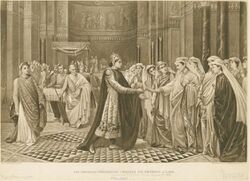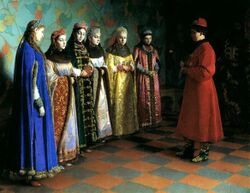Social:Bride-show
From HandWiki
The bride-show (Greek: δείχνουν οι νύμφες, romanized: deichnoun hoi nymphes; Russian: смотр невест, romanized: smotr nevest) was a custom of Byzantine emperors and Russian tsars to choose a wife from among the most beautiful maidens of the country.[1][2] A similar practice also existed in Imperial China.[citation needed]
See also
- Beauty pageant
- Book of Esther
References
- ↑ Bushkovitch, Paul (18 March 2021) (in en). Succession to the Throne in Early Modern Russia: The Transfer of Power 1450–1725. Cambridge University Press. p. 61. ISBN 978-1-108-47934-9. https://books.google.com/books?id=pAEbEAAAQBAJ.
- ↑ Martin, Russell E. (15 June 2012) (in en). A Bride for the Tsar: Bride-Shows and Marriage Politics in Early Modern Russia. Cornell University Press. pp. 23–27. ISBN 978-1-5017-5665-8. https://books.google.com/books?id=vf7-DwAAQBAJ.
Further reading
- Afinogenov, D. "The Bride-show of Theophilos: Some notes on the Sources", Eranos 95. 1997, pp. 10–18.
- Rydén, Lennart. "The Bride-shows at the Byzantine Court - History or Fiction?" Eranos 83, 1985, pp. 175–191.
- Treadgold, W. T., "The Bride-shows of the Byzantine Emperors", Byzantion 49. 1979, pp. 395–413.
- Bourboulis, Photeine, “The Bride-Show Custom and the Fairy-Story of Cinderella.” In P. P. Bourboulis, Studies in the History of Modern Greek Story-Motives. Thessalonike, 1953. Pp. 40–52.
 |



